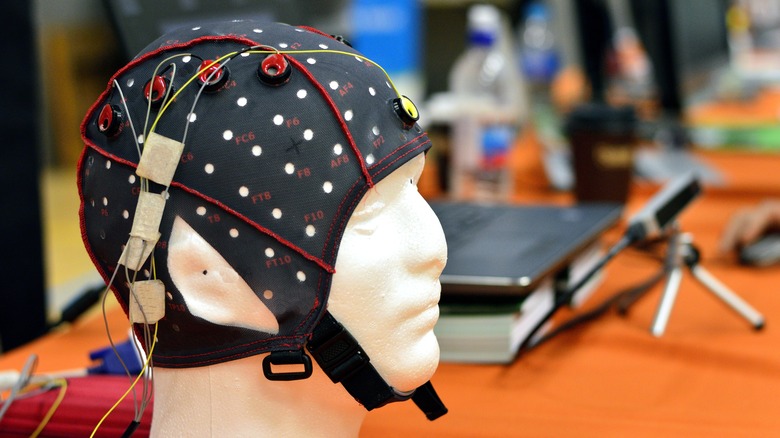How A New Mind-Controlled Wheelchair Changes The Game For People With Paralysis
Around 5.4 million Americans deal with navigating some type of paralysis. That's roughly 1 in 50 people in the U.S (via Cleveland Clinic). Paralysis happens when the signaling between your muscles and brain doesn't communicate properly. The body is then unable to voluntarily move certain muscles, explains MedlinePlus. Thus paralysis can be partial (you have some control of some muscles) or complete (you can't control any of the muscles), shares Cleveland Clinic. With that in mind, paralysis can be life-changing.
Because it may affect mobility, many mobility devices are often used to help individuals lead healthy and active lives. Assistive equipment like scooters and wheelchairs can be prescribed, as well as adaptive equipment which lets you drive yourself, points out Cleveland Clinic. Now, 2022 research published in the journal iScience shares that there's a new type of adaptive equipment for people with paralysis — mind-controlled wheelchairs.
Previously a person who was severely paralyzed needed to undergo brain surgery to be able to operate a motorized wheelchair with the power of their mind, explains U.S. News & World Report. However, this new study is changing the game because a person no longer needs surgery. Rather, the researchers explain that severely paralyzed people can control a wheelchair through non-invasive approaches like brain-machine interface (BMI) technology (per iScience). "This is probably the first small study to achieve quite good success without having to enter the brain," researcher Abbey Sawyer tells U.S. News & World Report.
Most participants gained more control of the wheelchair
To test it out, the researchers conducted a small study on three participants (per iScience). The BMI technology training lasted between two to five months, with training sessions three times a week. Using a powered wheelchair and an electroencephalogram (EEG) cap, the researchers taught participants two mental tasks that steered the wheelchair. To "go left" participants imagined moving their hands, while to "go right" they envisioned moving their feet, points out U.S. News & World Report.
During the first BMI training session, volunteers steered their wheelchairs with 43% to 55% accuracy (iScience). However, what the researchers found was that as the feedback training continued most of the participants' performance improved. One participant's accuracy grew to 95% while another volunteer increased to 98% (iScience). The other participant's accuracy stayed the same throughout training, shares NewScientist.
When analyzing the EEGs, the researchers note that they also saw an increase in distinctive brain signals for participants with high accuracy (via U.S. News & World Report). "There will be people who will learn it very fast and very well, then there will be others who will need more time to learn, such as Person 2, but I think anyone can learn to do it," explains senior investigator, José Millán, to NewScientist.
While mind-controlled wheelchairs may change the game for people with paralysis, more research is needed. In order to be effective, it needs to be easy and applicable, and people are still working on this, Sawyer tells U.S. News & World Report.


